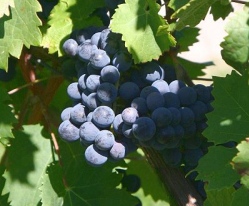Cabernet Franc is one of the "parents" of Cabernet Sauvignon, and one of the varieties of grapes that have been grown in the Bordeaux region of France for centuries. In the middle ages, Cabernet Franc was
known as the Breton, and it seems to have been brought to the Bordeaux region by the Romans. Cabernet franc vines bear a thinner-skinned grape than their offspring, and tends to bear grapes that ripen a little earlier. It's a bit more tolerant of cold winters, but the early ripening can mean it runs the risk of damage from late spring frosts. It's a bit of a gamble either way, but many growers choose to plant cabernet franc in areas that are likely to have rain at harvest; the earlier ripening can mean Cabernet Franc is ripe before the fall rains. Although it's one of the five core wines blended to produce Bordeaux, on its own Cabernet Franc is described as "fruity," and "spicy," even "peppery." The grapes are blue-black in color; they remind me of the darkest blueberries in hue.
